
36 minute read
AT HOME
Chairmen of the boards
Hardwoods run through Fricks’ family business, handsome home
Advertisement
A look from the Fricks’ kitchen toward the living room.
The hard maple border on the flooring upstairs carries into the separate stairs to the garage.



The boxed cherry joists in the living room provide a nice contrast against the poplar planks of the white ceiling. Andy Frick says the cherry comes from the Nantahala National Forest.

s he walks through the yard and buildings of Blandy Hardwoods in Gold Hill, Andy Frick knows the kinds of woods around him by their smell.
“Black gold,” he says, pointing to the stacked pallets of walnut. Andy then rattles off other varieties of hardwoods here on the Gin Road site, such as poplar, red oak, white oak, maple, ash and cherry.
When you have stacks of cherry and white pine in one of Blandy Hardwoods’ four dry kilns, “you talk about a nice smell,” Andy says, as though he’s describing the luscious aroma of hot dogs at a ballgame.
The lumber at Blandy Hardwoods comes mostly from saw mills in North Carolina, Virginia and Tennessee, but some also arrives from Maryland, Pennsylvania and New York. “We have some of the best mills in the industry,” Andy says of his sources. “The biggest thing is having great relationships with
Andy Frick describes how a lot of this wood will be shipped to Texas and be used for picture molding.

Just a few of the many stacks of wood at Blandy Hardwoods in Gold Hill.


Above: Andy Frick’s ‘man cave’ upstairs features a custom bar incorporating curly maple and tiger maple with some inlaid walnut that matches the flooring. The ceiling is wormy maple. Below: The stairs to the second floor feature wide, easy-to-navigate steps (made from hickory) with a spacious landing halfway.


Above: Andy and Machelle Frick stand at the front entrance to their home. The door behind them, built by a company in Rock Hill, features African mahogany.
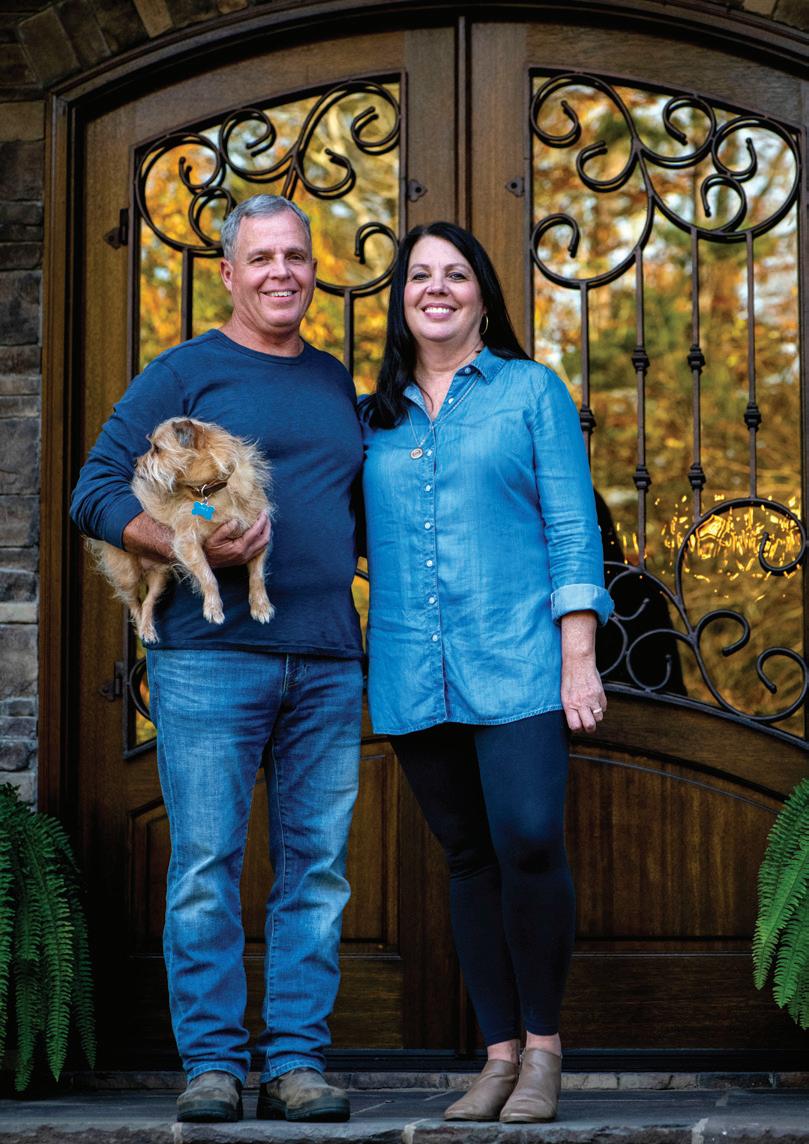

people.”
Much of the wood is stacked, dried and finished here before being distributed throughout the country and across the seas to the Far East, where Vietnam, for example, has become a good customer for low-grade poplar.
The Fricks’ hardwoods are used mostly in flooring, ceilings, cabinetry and molding for homes and businesses. The family operation, which includes Andy; his sons, Nathan and The long oak Lee; and brother Roger, has a German-manufactured table, not far saw for cutting molding for picture frames, and much from the frontof it goes to a big distributor in Texas. door entrance
Picture molding is a more recent application for their at left, provides lumber. room for the
“It’s funny how this corona mess has created things Fricks’ big we didn’t have before,” Andy says. “... Our biggest thing family, which is a lot of specialty.” includes seven
Some of their wood goes to New York and is used grandchildren. specifically for art museum crates. At times, it has been incorporated into the building of sets for soap operas and movies.
But if you want to see an up-close-and-personal application of the woods from Blandys Hardwoods, take a visit to Andy and Machelle Frick’s picture-book home, nestled on 52 wooded acres between Old Beatty Ford and Shive roads outside of Rockwell.
“It shows what can be done with wood,” Andy says. “... That’s the advantage when you own a lumber business. You can pick out the best.”
Andy Frick, center, with his sons Nathan, left, and Lee at Blandy Hardwoods in Gold Hill.


The painted green cabinets in the kitchen contrast well with the ceiling’s white planks of poplar.
In the ‘green’ building, a conveyor takes wood toward a stacker for drying purposes.

Andy and Machelle point out how wood — the family’s livelihood — makes up integral components in every room. Andy notes, for example, how there are 5,000 board feet of lumber from Blandys for the molding alone.
When they built the house 10 years ago, Machelle wanted a particular hand-scraped hickory (not from Blandys) for floors that run throughout much of the house. Plus, the flooring came with a 50-year warranty. Otherwise, the trim molding, ceilings, cabinets, stairs and some other flooring are made from woods off the Blandys lot.
Andy sometimes jokes and calls their house the “FrickA-Rosa,” a reference to the Cartwright family’s Ponderosa on the old television show “Bonanza.” Reid Link, a meticulous contractor, built the house, and architect Gray Stout designed it, based on trying to accommodate the things Machelle was sure she needed.
“What was I thinking?” she asks today, remembering how she and Andy were trying to down-size and somehow ended up with a house of about 5,000 square feet. Even so, Machelle claims she would still have a bigger kitchen if she had a do-over.
Andy shakes his head. “She got cornered like a kid in a candy store,” he says, remembering her conversations with Stout. “You know when you have grandkids, you’ve got to
have room.”
The Fricks, who have been married 41 years, have seven grandchildren thanks to Nathan, Lee and daughter Aubrey. Their house, with its long oak dining table, separate downstairs playroom, upstairs bedrooms and grounds to explore outside, has become a natural gathering place for family.
“Of course, we’ve had a couple of weddings here,” Machelle adds. • • •
Growing up off Dunn’s Mountain Church Road, Andy Frick was fascinated as a boy with the operation of a saw mill across the street from his parents’ house. He watched the cutting of timber and the shaping of round logs into flat boards. Representatives from furniture companies would stop in to grade the lumber, and often they would let Andy keep their tally books.
Andy’s dad, Norman, owned Frick’s Furniture, and his father-in-law, Joe Stirewalt, headed Piedmont Hardwoods. Andy became an expert in buying, grading and selling lumber. As a lumber inspector for Dixie Furniture in Lexington, he met Bill Brawley, who sold wood to Dixie.
Over time, Andy and Brawley went out on their own and founded Blandy Hardwoods in Statesville. “Blandy” was a combination of their names, Bill and Andy.
At first, it was just Andy, Brawley and a secretary. Andy likes to say he went into business with two lumber measuring sticks, a tally book and a marking crayon — a total investment of $70.
Brawley, who was much older than Andy, died in 1986, and the business passed to Andy, who quickly adapted to a changing industry. Today, he’s thrilled his sons, Nathan and Lee, are devoted to the business, and he calls brother Roger his right-hand man.
Nathan oversees the processing side of the business, while Lee works with suppliers and distribution yards.
“We’ve been extra blessed,” Andy says.
The Fricks bought their property off Gin Road in 1995, and now Blandy Hardwoods has 24 employees. “You’re only as good as the boys around you,” Andy says.
In the “green building,” freshly cut and de-
A closer look at the custom bar upstairs.



Left: In the ‘man cave’ upstairs, the walnut floor has a border of hard maple. Center: This finished wood is ready to be shipped out for use as picture molding. Right: Cypress provides many of the wood accents to the Frick house’s exterior, including these porch pillars.


A pull-in breezeway (center) separates the garage from the main house.

livered lumber passes down a conveyor and is taken to a stacker, where workers insert specially grooved sticks, so the layers of wood are properly separated for drying.
“These sticks have go to be laid right,” Andy says.
The stacks then go to one of the two-story kilns, fully automated for temperature and humidity. A boiler generates the steam that heats coils at the top. Huge fans force air through the lumber, and the moisture coming from the wood seeps onto the ground outside the kilns.
On this day, the poplar stacks inside a kiln are being dried at 150 degrees and 120 percent humidity. Each variety of wood is dried to different ratios in the kilns.
Andy considers the proper stacking, drying and finishing of wood an art. Drying alone can take from six to 12 days, depending on a lot of variables.
“You’re dealing with Mother Nature, and not every tree is the same,” Andy says.
The grades of wood are based on weight, grain and color.
On the yard, the Fricks have cherry, soft maple and red oak from the Nantahala National Forest in western North Carolina. Andy refers to other wood from the Cherokee National Forest. All the lumber harvested from these national forests are part of forest management plans, and


Left: The green cabinets in the kitchen also come close to the green exterior of the Fricks’ house. Above: Finished wood at Blandys that will be used for picture molding. Right: Blandy Hardwoods in Gold Hill deals in a variety of woods, including poplar, red oak, white oak, ash, walnut and cherry. They are used in many building applications such as ceilings, flooring and molding.

Andy says proceeds are supposed to go to schools in those particular counties. • • •
Andy and Machelle Frick’s house is worthy of a home tour. Highlights include its poplar ceilings; boxed cherry joists in the living room; touches of wainscoting; a two-story chimney with fireplaces for the living room inside and the patio outside; front doors of African mahogany, glass and wrought iron; and an attractive, easy-to-navigate stairway to the second floor.
Link, the contractor, made sure to provide the stairs with extra wide treads of hickory and short distances between the steps, besides a spacious landing halfway up. The talented Gary Curlee did a lot of the woodwork in the house, and F&G Molding of Spencer ran all the poplar molding.
A three-car garage is punctuated by three dormers. The house’s roofline also includes a cupola, weather vane and chimney pots. Cypress has been used for many of the wood accents on the exterior.
An attractive, highly useful breezeway connects the garage to the house. There’s a pine ceiling for part of the stone patio out back and an ash ceiling on the porch out front. Andy likes the ash better.
Back inside, the couple have a first-floor master bedroom with a fireplace. Machelle also has a well-appointed sewing room downstairs, while Andy’s man cave upstairs includes another fireplace, a custom bar, Skeet ball and PacMan machines, an old chess table from a beloved uncle and a framed Pat Mahomes Kansas City Chiefs jersey.
Andy retreats to the man cave with family and friends to watch games in a separate television viewing alcove. This whole expansive area has walnut floors with hard maple as borders. The ceiling is wormy maple.
“It really goes together well,” Andy says of the dark flooring with the maple accents. The room has a separate stairway of hard maple going to the garage.
Billy Heilig crafted the bar, which features curly maple, tiger maple and an inlaid
Andy Frick likes the look of this wormy maple ceiling upstairs.
walnut that picks up the floor color.
“Nathan’s house is also filled with beautiful wood,” Machelle says. It’s an indication that the family love of wood runs deep.
The Fricks actually built two other houses between Old Beatty Ford and Shive roads before their present home — one in 1983; the second, in 1990.
The 52 acres have been in the family since Andy’s dad, Norman, traded furniture for the property in 1966. It still has the original weath-
A plank makes its way on a conveyor to where it will be stacked for drying.

er-worn farmhouse, barn and smokehouse, long forsaken to the elements, though Andy keeps a tractor and firewood in the old barn.
He loves looking toward the buildings from his back patio, and they become more visible when the leaves are down. The old structures are surrounded by hardwoods, and to the Fricks that’s like having a lake view.
“A lot of people don’t realize how nice and pretty it rolls,” Andy says of the land. “It’s just beautiful.” S

FIELD of dreams
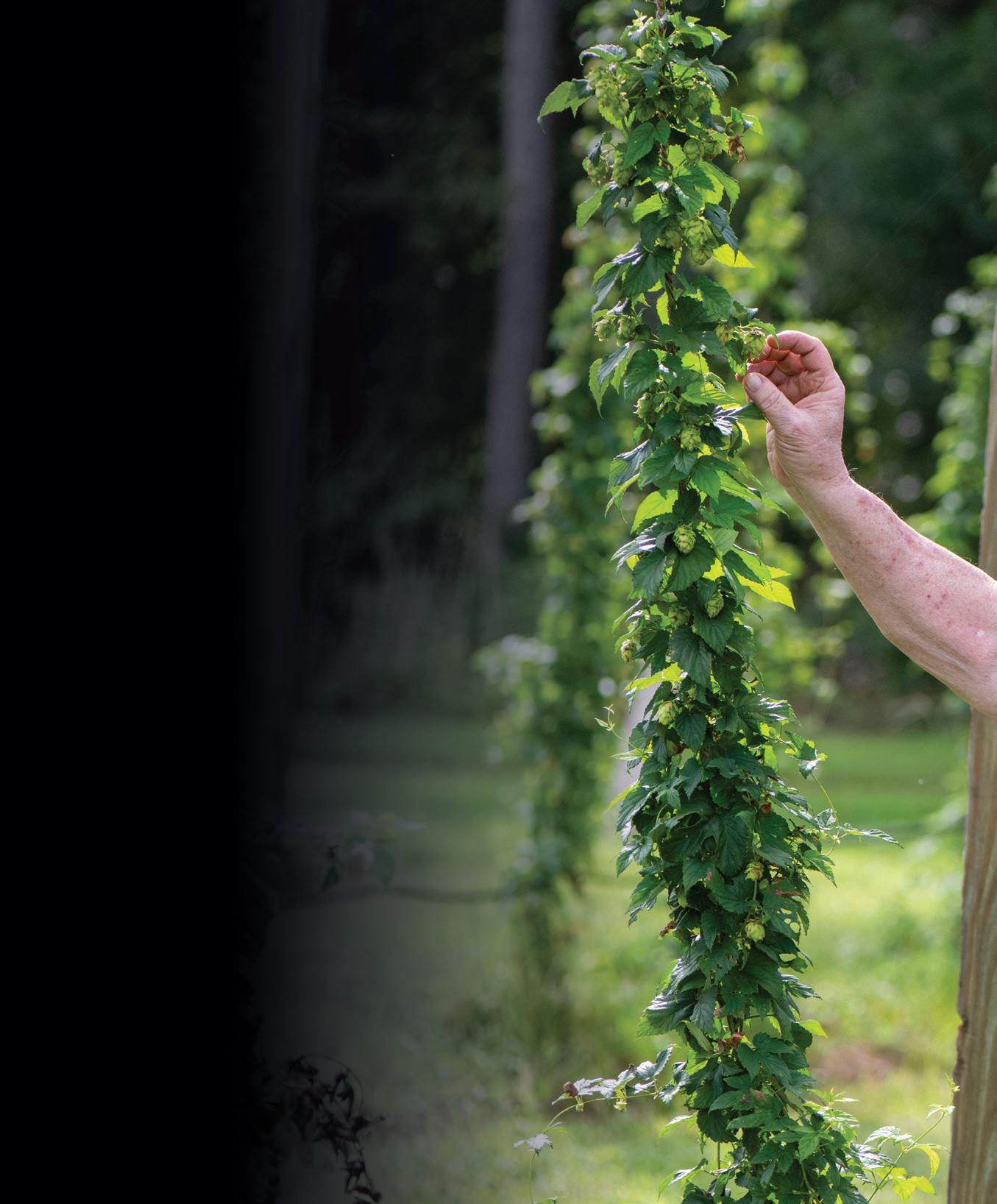
ENTERPRISING COUPLES BRING HOPS TO LOCAL BREWERS, SUPPORT CAUSES
written by MARK WINEKA photography by JON C. LAKEY
Joe Martin, who handles the marketing duties for the hops enterprise, checks on one of the bines.
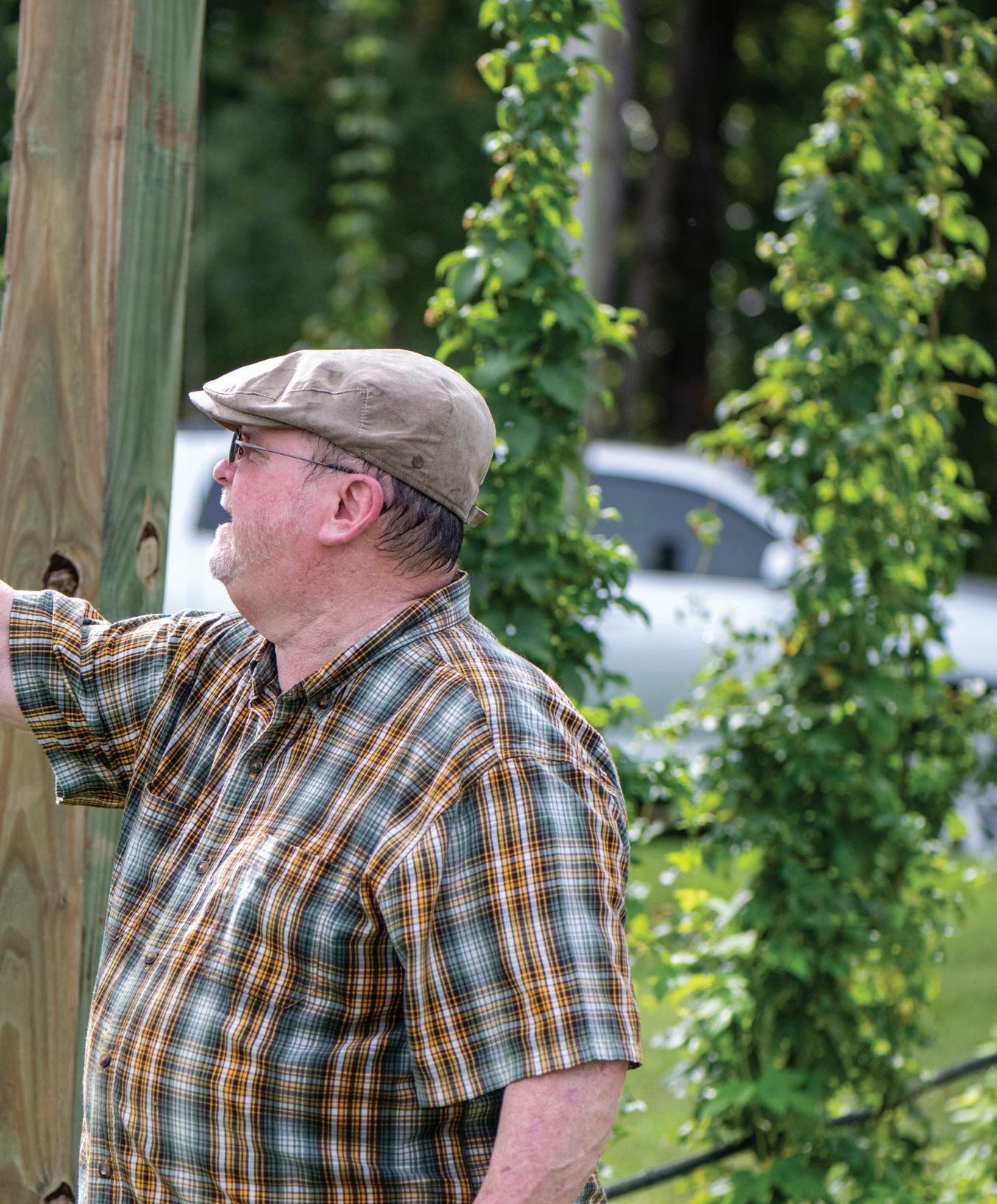
A look inside the hops flower. Hops provide the alpha and beta acids to beer, while serving as its bittering, flavoring and stabilizing agent.
Nancy Faller talks with a visitor to the fields about the finer points of hops.


Let your mind wander for a moment and picture driving through the German countryside, passing a field with hops growing as far as the eye I can see.
The truth is, you could be in Davie County off Boxwood Church Road in Mocksville. And you’ve come upon almost 5 acres that make up Hoppin J’s Farm, a young endeavor by two couples who are old friends.
The harvesting of the hops takes several days in late summer.
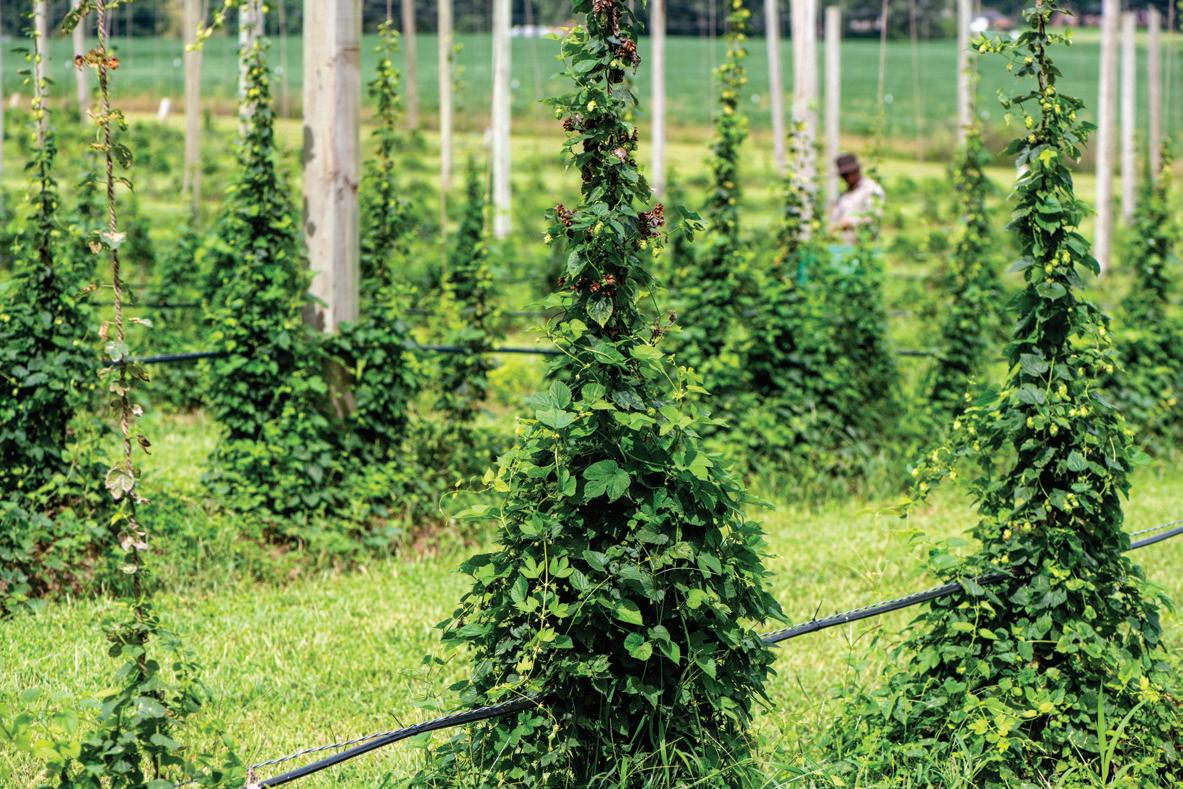
In their field, hops vines — or “bines,” as they are called — grow on strings (or coir) some 20 feet high, supported by a vast network of similarly tall wooden posts and crossing wires. It provides the framing for more than 6,500 hops plants in five different varieties.
The partners started in 2018 with an acre of Cascade, the hops variety maybe most familiar to craft beer brewers, and now with 3.5 additional acres, they are growing four more kinds — Chinook, Nugget, Zeus and Canadian Redvine.
“We’re the largest hops grower in North Carolina,” says Joe Martin, one of the “J’s” in Hoppin J’s Farm.
Hops represent the flowers of the plant humulus lupulus, and these abundant, mostly cone-shaped flowers add alpha and beta acids to beer and serve as its bittering, flavoring and stabilizing agents. They provide the fruity, floral flavors and aromas a beer might have.
Martin, who has taken on the marketing responsibilities for the couples’ enterprise, notes how their growing of hops combines agriculture, craft breweries, restaurants, cosmetics and — most important to the foursome —
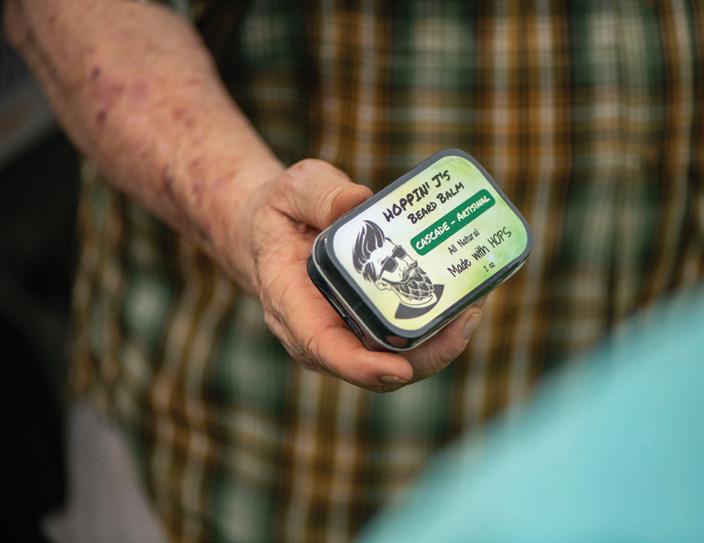
charities.
Their hops are sold to craft brewers in Salisbury, Charlotte, Statesville, Lexington, High Point and Greensboro, among others. Some Italian chefs in the region pay for hops sprouts in the spring to use in their recipes. Hoppin J’s Farm also captures the oils from hops and adds it to lip balm, beard balm A New Sarum and hand sanitizer. label shows that the
Part of the farm’s proceeds will go to support two organizations: hops for this beer the Paradox Foundation and Wounded Warriors. came from Hoppin
Joe’s wife, Nancy Faller, is chief overseer of Paradox Farm, her J’s Farm in Davie personal animal rescue effort of more than 15 years. Joe and Nan- County and the cy are anesthesiologists by trade — “Paradox” comes from “pair of malt from Carolina docs” — and they have devoted their own large farm along U.S. Malt House in 601 to the rescue and care of dogs and horses, but also pot-bellied Cleveland. pigs, sheep, goats, chickens, peacocks, mallards, geese and even emus.
That farm is run as a not-for-profit foundation, also offering educational opportunities for visiting students. Salisbury the Magazine featured Paradox Farm in its September 2018 issue.
The other couple in the Hoppin J’s Farm enterprise are J.W. “Jay” Phelps and his wife, Liz Phelps, a published and self-described romantic suspense novelist whose pen name
Liz Phelps prepares a bine for the cultivator.
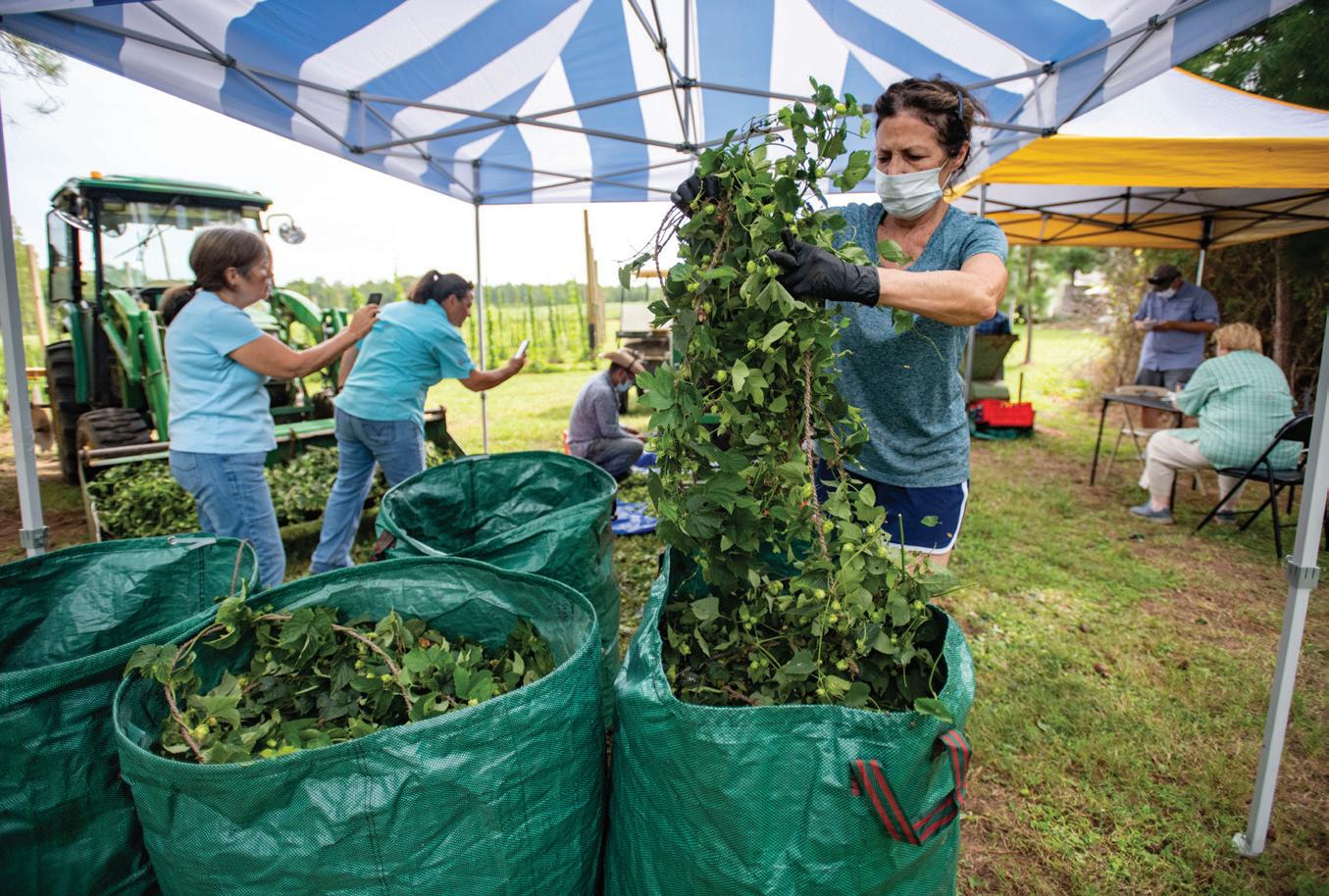

Above: Nancy Faller weighs a bag of ‘wet’ hops that will be shipped to a brewer in Greensboro. Below: Jay Phelps keeps all the harvesting machines going. Hoppin’ J’s hops farm has close to five acres of hops.
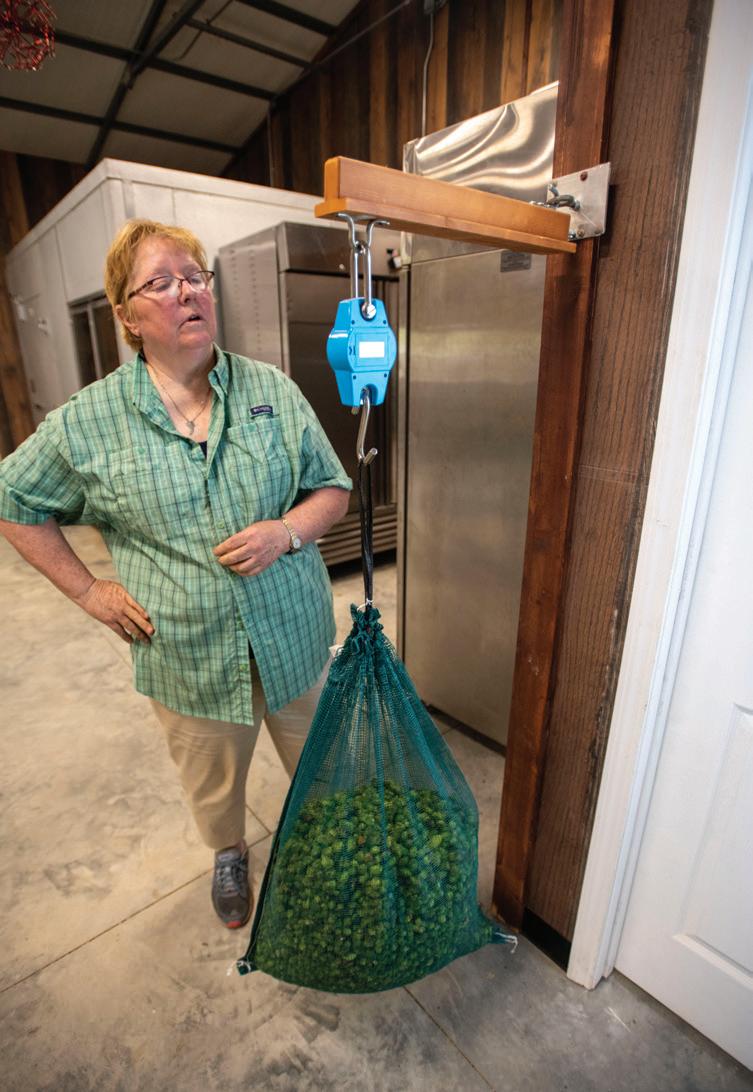


is Liz Shoaf.
Jay owns Phelps Wood Products off Redmon Road in Cleveland, and that served as a great connection to secure all the wooden posts needed for the hops operation. Jay served in the Army for five years and at one time was commander for the honor guard at the Tomb of the Unknown Soldier in Arlington, Virginia.
He has a deep passion for wounded veterans and their families — the reason for monies going to the second charity.
A farmer at heart, Jay also is considered the hops operation’s chief engineer and soil manager. While Joe does the marketing, Nancy handles the processing side, including the drying and pelletizing of the hops. A bookkeeper for Jay’s lumber business, Liz also does the accounting for Hoppin J’s.
When hops harvest time comes in late summer, Joe, Nancy, Jay and Liz all report to the fields for several days, along with some farmhands. “We go from sun-up to sundown,” Nancy says.
The couples have been good friends for 25 years, and they learned quickly it probably would be three years before they could make any money with their hops. (Plants take up to three years to mature fully.) The fourth year, coming up in 2021, is when they think Hoppin J’s will become profitable and they can start funneling some of the proceeds toward the nonprofits.
“I told him we’re still figuring it out,” Martin yells to

In late summer, the hops are ready, and a harvesting station is set up next to the fields.

A cultivator separates the hops from the bines.

These harvested hops are ready to be dried or shipped off immediately to brewers.

The twine on which the bine is growing is called a coir.
Phelps as he refers to one of the day’s visitors.
“We are,” Phelps yells back over the sound of a harvesting machine next to the fields. • • •
So how did this wild idea ferment?
The couples were eating one night at La Cava, their favorite Salisbury restaurant, when La Cava owner Gianni Moscardini, also a principal in New Sarum Brewing, said he wished he could find hops grown locally for the brewery instead of buying them from the Northwest United States.
A light went off for the men at the table. Jay looked at Joe and said, “I’ve got a tractor, you got a tractor, and we both have land.” It was pretty much decided at that moment they would try growing hops on part of Jay’s property, though they knew nothing about it.
The wives were on board from the start. Liz remembers that fateful dinner. “We were all pretty excited about it,” she says. “It had potential to be a fun thing to do.”
On this particular day in September, workers are going through the fields, taking down the bines and bringing them to a harvesting station the couples have set up nearby. Laden with hops, the bines can grow 20 to 25 feet high once they
Joe Martin, right, goes over some of the things happening with the hops harvest with Marsha McGraw, center, field crop extension agent for Davie County, and Susan Hawkins, horticulture agent for Davie.

are established. They are trained to grow up their twine or coir in a clockwise direction.
The coir is attached to the top crossing wire with an “S” hook. When harvesting comes, you cut each vine at the bottom and pull on the coir, which bounces it off the hook at top. The bines then go to the station.
The couples rely on a used hops harvester from Wisconsin that separates the cones from the leaves as the bines are stripped. “We’ve never been so happy as when we got this machine,” Nancy says.
Jay also adapted a fertilizer spreader, which is used to fill bags with the harvested hops. • • •
Today, the couples are preparing 5 pounds of hops for the Pig Pounder brewery in Greensboro and 60 pounds for New Sarum in Salisbury. New Sarum requested at least 20 pounds of the Chinook, 10 pounds of the Zeus, 10 of the Nugget and all the Canadian Redvine harvested to date.
Hoppin J’s Farm usually receives its orders from craft breweries in these kinds of increments. For brewers wanting their hops “wet,” the hops are bagged in green mesh and immediately delivered. Any hops not sold wet are taken over to a new, air-conditioned build- A cultivator separates the hops from the bines.

ing on nearby Paradox Farm, where the cones are placed on drying racks for 12 hours. A hop oast is the name for the drying room, where the temperature stays at 98 degrees with fans and a dehumidifier.
After they are dried, the hops are put in bags, flushed with nitrogen, vacuum-sealed and placed in a freezer for storage.
Again, Nancy oversees this processing side of the operation. She also is the pelletizer. “A lot of the brewers want pellets,” she says, even though pellets are more cost-prohibitive, because it takes five pounds of hops to make a pound of pellets.
In this same building, a distilling process captures oils from the hops that go into a Hoppin J’s lip balm and beard balm. In his dealings and communications with N.C. brewers, Joe noticed that most men in the industry sported beards.
At last year’s N.C. Craft Brewers Convention, Joe handed out free, hops-infused beard balm with the Hoppin J’s logo on it. It was a three-day conference and “the first day, they were gone,” Joe reports.
The hops oils also have gone into hand sanitizer made for New Sarum.
Joe says he has been in touch with every single brewer in North Carolina. He invites them to the fields, wanting them to see, touch and smell the hops they could be getting from Hoppin J’s Farm, which he thinks benefits greatly from the land’s having been covered thousands of years ago by the Yadkin River. It provided a soil today that’s “rich and loamy, a wonderful mixture of sand and clay,” Joe says.
The soil seems to be especially good for the Canadian Redvine, a lesser known variety than the farm’s other four. “Here, it’s doing great,” says Joe, who also gets excited about the idea that brewers such as New Sarum can go virtually 100 percent local with malt from the Carolina Malt House in Cleveland, hops from Hoppin J’s Farm, maybe even strawberries from Patterson Farm.
In the spring, the hops growers chemically burn back the plant when they first start to emerge, helping to eliminate bull shoots. But some of the sprouts are sold to Italian restaurants eager to have them.
“We have a chef in Charlotte — Chef Grigo Grigolon of Aqu e Vino — who went absolutely crazy when he found out we had hops,” Joe says. A bine, laden with hops, grows almost two stories high before its ready for harvesting in the late summer.

“He is Venetian, and he said that as a boy they would go out and find hops shoots, since it was considered a delicacy. ... Each one has a different flavor.”
The couples’ hops operation also has become a laboratory for others.
During this day of harvesting, Susan Hawkins, horticultural agent for Davie County, is visiting the fields with Marsha McGraw, field crop extension agent for Davie. They are looking at options for weed control around the hops plants.
“You know, we’re still learning, too,” McGraw says. noting that broadleaf weed control doesn’t necessarily work. One of hops other enemies is mildew, because it can lead to fungus.
Before the pandemic, cooperative extension agents from a 20-county region visited Hoppin J’s Farm. “They had never had a hops tour,” McGraw says.
Hoppin J’s Farm will be part of the University of North Carolina at Greensboro’s three-year grant to archive the craft brew industry and its history in the region. Researchers plan to visit the hops operations for interviews and videos in 2021.
In addition, N.C. State University researchers are applying for a grant to test two new hops varieties they are developing for this region of the country. “We will be the test site to do the research on the commercial application,” Joe says. “We think the grant has a real good chance of coming through, and we would be working with them this spring.”
Meanwhile, the multi-talented couples say they’re having fun pursuing their other interests as well. A wine connoisseur, Joe has adapted a lot of those skills toward becoming a certified cicerone, a designation showing that a person knows about proper beer service, storage, style, history and food pairings with beer.
Nancy competes in horse and carriage competitions. Liz is involved in dog sports with Mr. Bates, her Belgian Malinois. Liz, the author, reveals that husband Jay’s personality and military background serve as the basis for her character Austin McKean in her novel “Mirror Images.”
Jay and Joe say the economics of the couples’ enterprise will decide how much they expand, though Jay claims they have enough land to be as big as they want. The men smile, saying they’ll eventually figure out this hops-growing business and give their blessings to others who want to try it.
“We learned all this by doing,” Joe says. “All we had was land and tractors.” S
Above: Meeting recently at the Rowan District Scouting office in Salisbury were left to right, Henry Fairley, former District Executive Dieter Stoelting, Jack Kepley, Marny Hendrick and Terry Holt. The legendary Kepley has been involved with Scouting through Troop 448 for 83 years. Below: In 1982, during Troop 448’s 50th anniversary, a Scout models a much earlier uniform for his fellow Scouts to take in.

LEADING EDGE SCOUTING CELEBRATES 100 YEARS IN ROWAN COUNTY

written by MARK WINEKA
One of Terry Holt’s highlights as a Scoutmaster — something he’ll never forget — was a day when he received at random four different emails from Eagle
Scouts who were once part of his Troop 375 in China Grove.
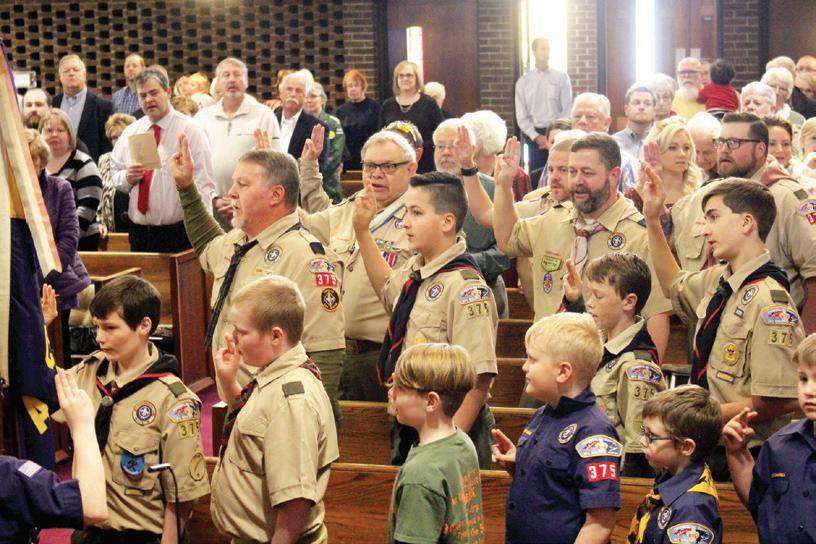
Troop 375 at First United Methodist Church in China Grove participates in the Scout Sunday service in February 2019. It’s an annual service repeated in many Rowan County churches which sponsor Scouts packs and troops.
Each of the messages came from Iraq, where these four young men in the military were serving in harm’s way. One of the guys worked on helicopters, two were infantrymen and a fourth was a fighter pilot.
By sheer coincidence, they had reached out to their old Scoutmaster on the same day.
“I’m sorry,” Holt says, thinking back, “I’m wet about the eyes.”
One of those men was his son, Justin Holt, who today the Veterans Administration classifies as 100% disabled. That hasn’t stopped Justin’s recent preparations to assume the role of Scoutmaster for Troop 375.
Another of those guys, now a commercial pilot, once was the captain for Air Force Two, the official plane for the vice president of the United States. Yet another of Holt’s Eagle Scouts is a lieutenant colonel today. Holt remembers the time in that man’s basic training when he was taken away from the base in a truck (with other soldiers on the same exercise), cast off in the middle of nowhere and told to find his way back to the barracks.
The former China Grove Scout beat the truck’s return to the base, and he told his surprised superiors, “I’m an Eagle Scout. I know how to read a map.”
“Those are the kinds of men we have nurtured,’” Holt says.
Despite a well-publicized bankruptcy and sex-abuse litigation against Scouts BSA as a national organization, Scouting in Rowan County continues to exert a positive influence on the lives of boys and girls, as well as young men and women. So say county Scout leaders.
“The principles of Scouting have not changed,” says Jack Kepley, arguably the granddaddy of Scouts in Rowan County. The Scoutmaster emeritus of Troop 448 at Coburn Methodist Church has been involved in the organization as a Scout and state and nationally recognized leader for 83
This newspaper photograph from Sept. 8, 1929, shows the first three Eagle Scouts in Salisbury. Left to right are Clyde Sowers, Archie Coleman and Melvin Spencer. Sowers belonged to the troop at St. John’s Lutheran; Coleman and Spencer, to the troop at First Presbyterian Church. Spencer is considered the first boy to become an Eagle Scout in Rowan County; Sowers, the second.

years.
The beauty of Scouting is that it brings together different kids with varying abilities, and they learn to work together as a team, says David Wilson, Scoutmaster for Troop 442 at First United Methodist Church in Salisbury.
Kepley, Wilson, Holt and other Scout leaders such as Marny Hendrick, Henry Fairley and former Rowan District Executive Dieter Stoelting sat down recently with Salisbury the Magazine and said Scouting will always stress leadership, character development, citizenship and personal fitness.
“It’s a universal program,” says Stoelting, an Eagle Scout who grew up in Indiana. “We hold them to a standard.”
This year — 2020 — represents the 100th anniversary of Scouting in Rowan County, which presently has 42 Scouting units. They encompass Cub Scout packs, Boy Scout troops. newly established girl troops (not to be confused with Girl Scouts), Venture crews and Explorer programs.
Over the past century, Rowan County — known as the Sapona District — has had at least 140 Scouting units, most of which were affiliated with churches. Of those, 79 have produced Eagle Scouts.
In fact, Rowan County has had (as of this publication date) just shy of 1,900 Eagle Scouts over the organization’s history here, “which is kind of an impressive number,” says Fairley, a member of the Sapona District board, its historian and the Order of the Arrow advisor.
Some of the recent local growth in Scouting has come from girl troops, of which there are five in Rowan, with a sixth on the way. Females were first allowed into Scouts BSA in 2019. Again, these troops are not the same as Girl Scouts, a separate organization. There are no coed Scouts BSA troops, but joint activities between girl troops and boy troops belonging to the same chartered organization are allowed.
For Cub Scouts (ages 5-10), girls and boys can be members of the same pack, but there are separate dens for boys and girls. Venture crews are for high school-aged youth and can be coed.
Hendrick, also a member of the Sapona DisLongtime leaders with Troop 442 in Salisbury, David Wilson, left, and Bruce Kolkebeck rest at the top of the Tooth of Time peak during one of the several trips they’ve led for local Scouts to the Philmont Scout Ranch in New Mexico.

Scouts from Troop 448 take on some mountain whitewater.

trict board and its District Eagle Board, says the first Eagle project for a female Scout in Rowan was set to be reviewed in early November. She emerged from a Venturing program.
Fairley and Hendrick are co-chairmen of the 2021 District Banquet Jan. 30. The banquet will celebrate the centennial year of Scouting in Rowan while also serving as the annual leadership recognition event. New Eagle Scouts will be noted, and the night will kick off the Friends of Scouting campaign.
If COVID-19 precautions allow, the celebration will be held from 6-9 p.m. at the Salisbury Civic Center. The alternate site will be the Rowan County Fairgrounds. Guest speakers will include Kepley, Salisbury Mayor Karen Alexander and Salisbury attorney (and Eagle Scout) Bill Graham.
Troop 442 Scouts take a break during a Uwharrie River canoe excursion.
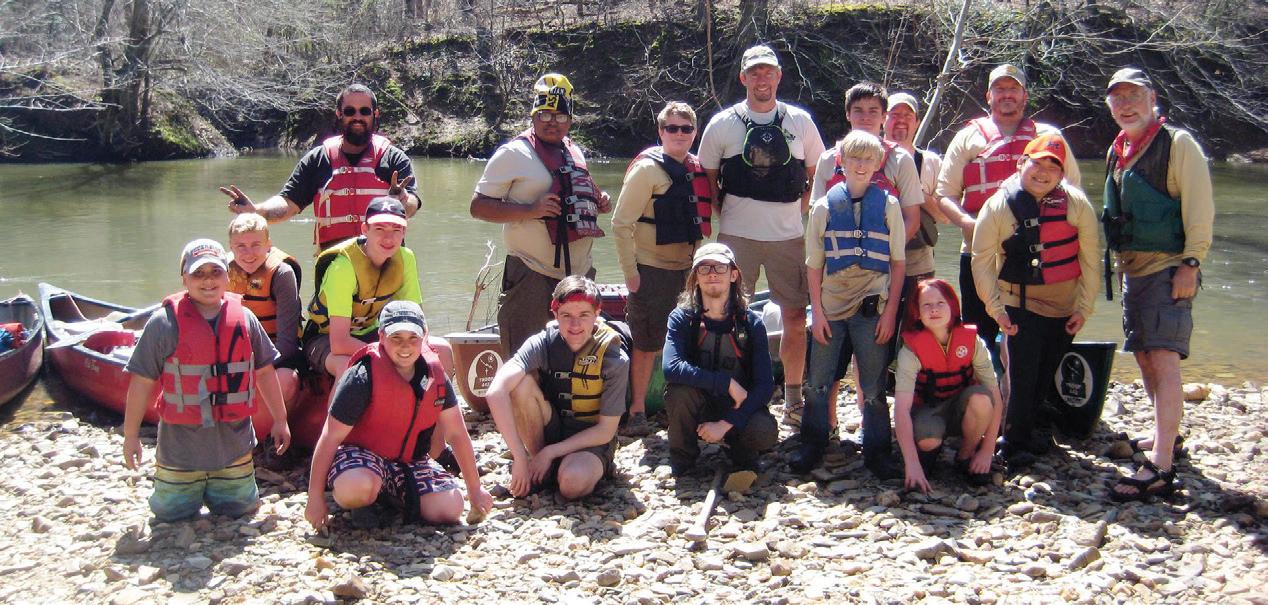
“It will be a night to remember,” Hendrick promises. • • •
Think of Scouting in Rowan County over a century and a flood of memories and images come to the fore. The organization here is synonymous with popcorn sales, oyster roasts, Pinewood Derby races, district camporees, Scout Sundays at church, Camp Cards, Scouting for Food and other Eagle Scout projects that have made the community better.
Local Scouts, their parents and leaders know all about summer weeks spent at Camp Barnhardt in Stanly County, hiking on the Appalachian and Uwharrie trails, overnight visits to the USS Yorktown in Charleston, S.C., whitewater rafting, biking on the Creeper Trail in Virginia, canoeing and kayaking on state rivers, weeklong trips to Washington, D.C., and the National Jamboree at Fort A.P. Hill.
Five times in the past, Kepley’s Troop 448 traded excursions abroad with a companion Scout troop in Wales. For high adventure, hundreds of other local Scouts have traveled to the Philmont Scout Ranch in New Mexico or Sea Bases in the Florida Keys, Bahamas or Virgin Islands.
“If you can think about it, Scouts have done it — and there’s a patch for it,” Hendrick says.
Scouts can earn a diversity patch, and the leaders say they are not sure whether there’s a more diverse organization than Scouting. In many instances, the diversity comes from the different churches and religious backgrounds participating in the sponsorship of troops.
Friendships made in Scouting tend to run deeper than Members of Troop 448 posed for this 1994 photo on Brownsea Island, the birthplace of Scouting, during their second exchange program with Scouts in Wales.
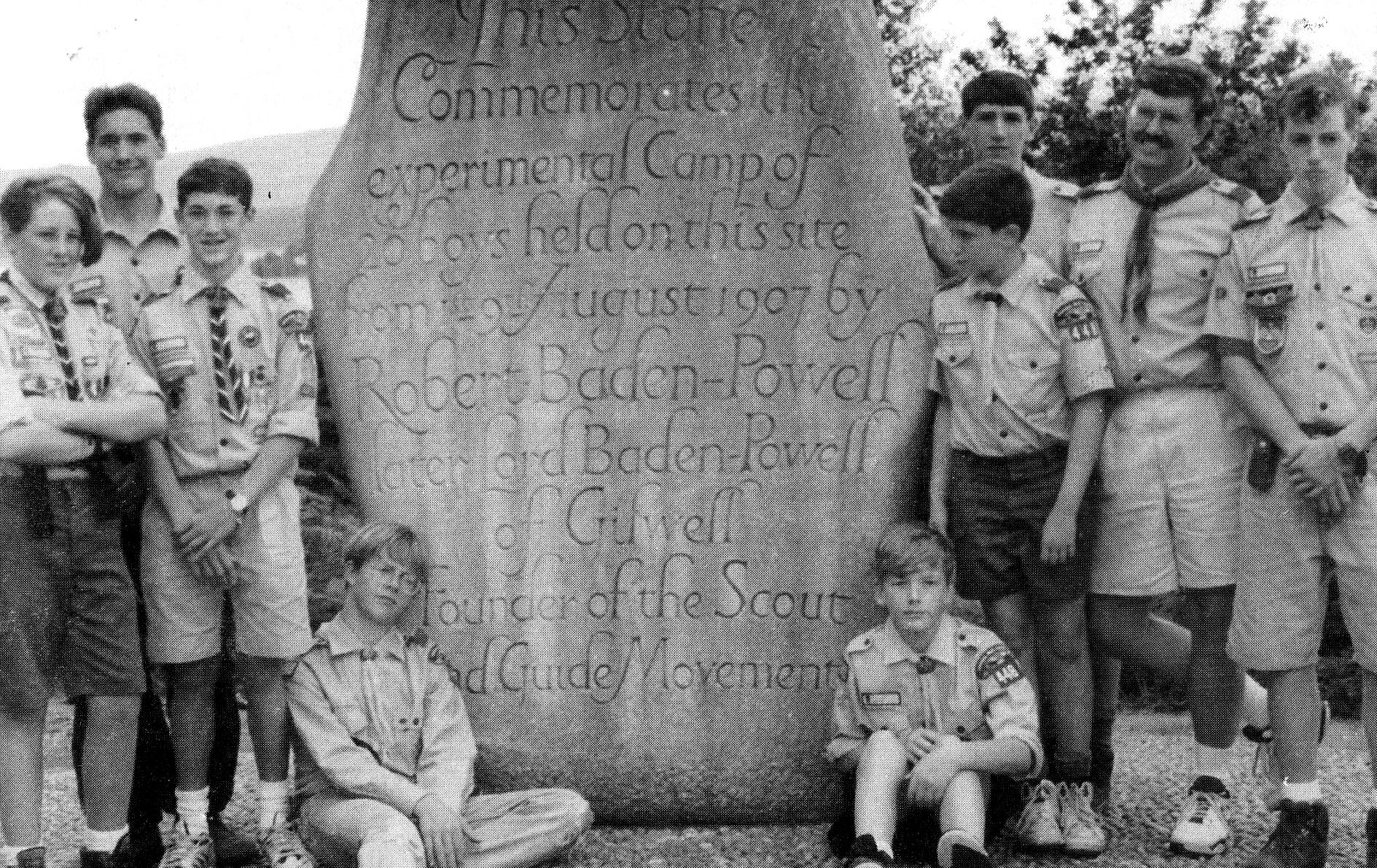
Ebenezer Lutheran Church’s Pack 328, under the leadership of Cubmaster Kevin Fuller, center, learns the proper ceremony for retiring a U.S. flag. Also pictured are Curtis Furr, Maddie Godfrey, Joseph Clark, Morgan Clarke and Assistant Cubmaster Craig Clarke (seated).

In October, Troop 448 conducts an Eagle Scout ceremony for Alexander Maggard.
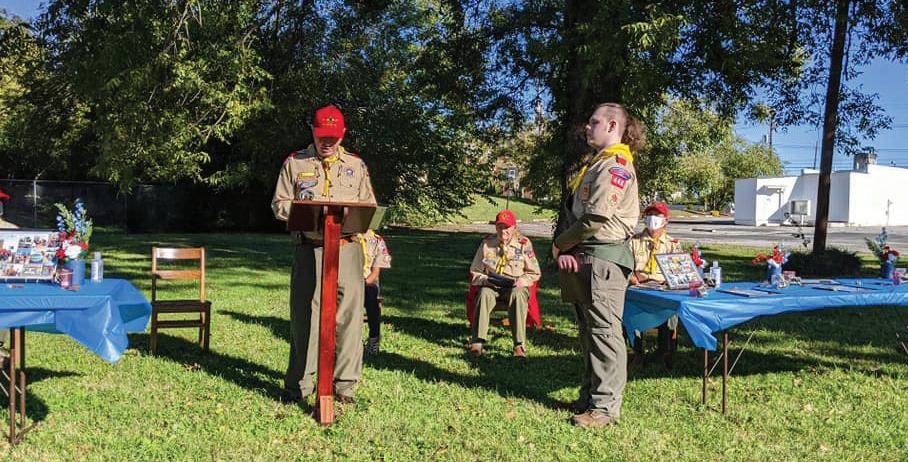

in other activities, Wilson adds. His troop has had Scouts from or with ties to South Africa, Germany, Poland, Iran, India, Vietnam, Korea, England, Ukraine and Russia.
“These are examples of how Scouting brings people together,” Wilson says. “It builds bonds and people learn lessons from these bonds. I have friends all over the country that I’ve met through Scouting.”
By policy if not practice, racial segregation in Scouting discontinued in the 1950s. Fairley reports that Rowan County might have had the first Black troop in North Carolina. Organized in 1931, Troop 15 met at the Lincoln School.
“The BSA has always been open to all without regard to religion, race, ethnicity or socio-economic status,” Wilson says. “Today, BSA is more diverse, more inclusive and safer than ever.”
While the abuse scandal has rocked the national organization, the Rowan County Scout leaders say the current vetting of adult leaders and the youth protection training in place are strong locally.
Rowan Scouting is part of an independent (not bankrupt) council — Central NC Council, which takes in Rowan, Cabarrus, Union, Richmond, Stanly, Anson and Montgomery counties. Rowan previously was part of the Uwharrie Council from 1924-1965. • • •
It was the work and inspiration of T.B. Marsh Jr. who brought Scouting to Salisbury in 1920. He initiated Scouting programs out of his work with boys connected to the YMCA.
“The YMCA organized an older boys conference for Oct. 11, 1920, when 154 young people from this region came together to meet in First Methodist and First Baptist churches for a song service, speeches by community leaders and a barbecue at the fairgrounds,” Martha Hines Morehead said in a local history.


Clockwise from top left: From left, Dylan Harrington, Andon McCullough and Kyle Gillespie handle flag-raising duties for Troop 324 of Rock Grove United Methodist Church; On an outing this fall, Neal Powell led members of Troop 442 through the Olde English Cemetery as part of their efforts toward earning a Citizenship in the Nation merit badge; In 1983, Troop 448’s Clay Lindsay met then Gov. Jim Hunt when Lindsay presented the Central NC Council’s annual report.

“The purpose of the conference was to encourage an enthusiasm in the group to join their local Sunday School classes, high school clubs, employed brotherhood groups and the Boy Scouts.”
Two days later, Marsh had organized two troops — Chestnut Hill Troop No. 2 and Kesler Mill Troop No. 3. St. Luke’s Episcopal apparently had tried to form the first troop in Rowan County a bit earlier but it had been abandoned “with a change of pastorates,” Morehead said. Troop No. 1 was later assigned to St. John’s Lutheran.
But St. Luke’s re-established a troop later, and other early units in Salisbury from the 1920s included those at First United Methodist, First Presbyterian and First Baptist churches.
According to Fairley’s research, Melvin Spencer of Troop 44 at First Presbyterian was the county’s first Eagle Scout, earning the distinction in 1929.
The numbers given to troops in Rowan County are confusing because they do not reflect the sequential order in which the troops were founded.
Leaders says the easiest way to think of the troop numbers today is that the “400” numbers are Salisbury-based units, and the “300” numbers are units
At Camp Barnhardt this autumn, Cub Scout Matthew Clark of Pack 328 at Ebenezer Church takes aim with a BB gun during target practice at a Sapona (Rowan) District Fall Family Fun Fest. Helping out is Assistant Cubmaster Jack Godfrey.

outside of Salisbury but still in Rowan County.
Rowan Scouting’s largest membership numbers probably came in the 1970s, and that’s borne out by the national organization, which says its peak came at more than 4 million Scouts in that decade. Reports put the current national membership in BSA Scouts at less than 2 million.
Fairley notes 1973 had the most Eagle Scouts in one year — 71. Today, the average is 25 to 30 a year.
When it comes to earning merit badges and, if they desire, becoming Eagle Scouts, there are no shortcuts, the leaders say. Scouts do what is required of them, and they’re fully vetted.
“We support our Scouts every step of the way,” Stoelting says, but the accountability and responsibility to do the work is on them.
Speaking around a conference table recently, the handful of Sapona District leaders marvel at all the kids, leaders and families as a whole who have been involved in Scouting over 100 years. From 1976, this boys and girls Sea Explorers Crew included, from left, Mark Eagle, Bill Weatherford, Annette Smith, Younger Mattox, Lisa Snyder, David Miller, Donald Byerly, Patty Tarlton and Worth Murdoch.

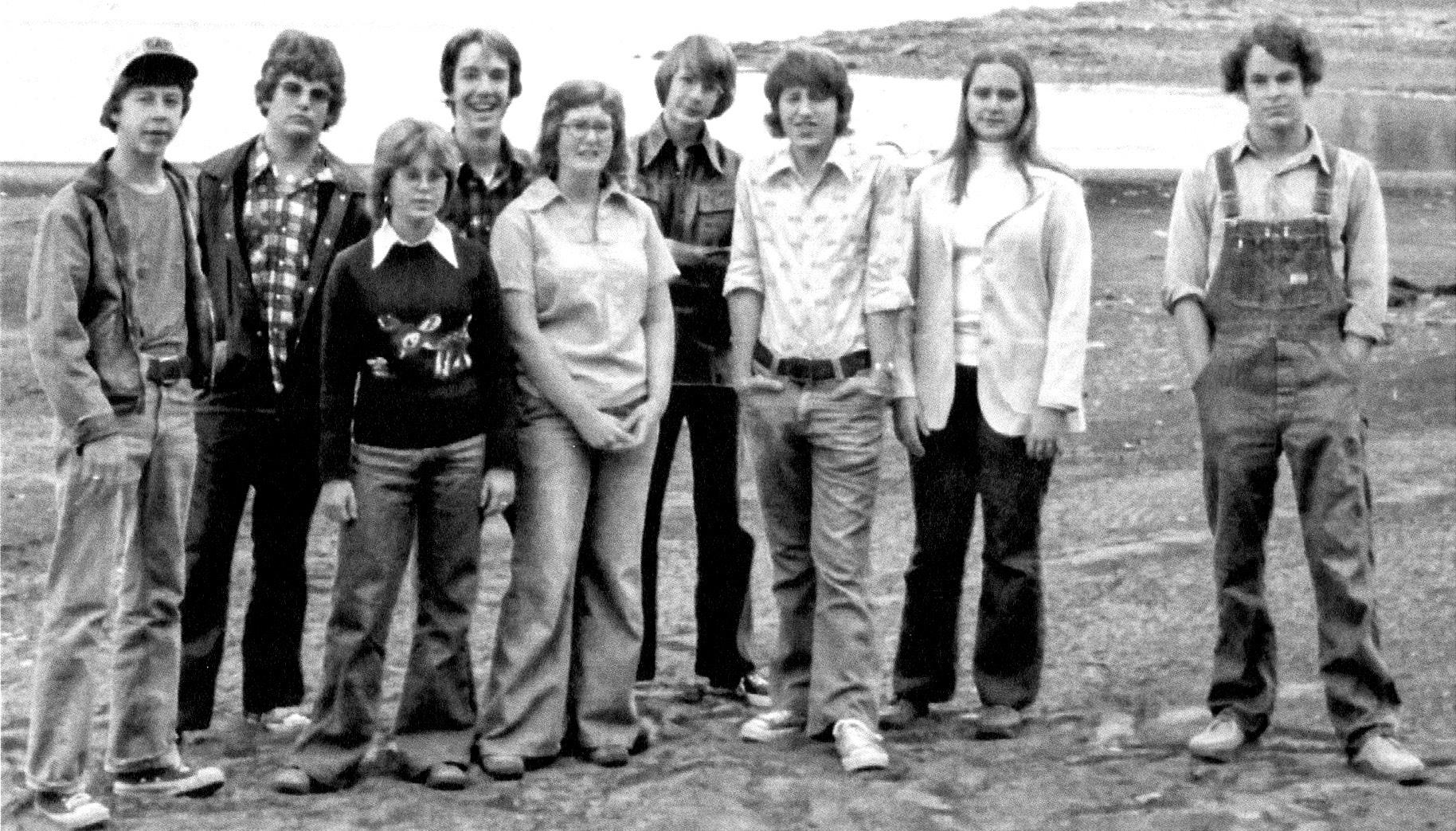
MEDICINESHOPPESALISBURY.COM
“Scouting is just not us sitting here,” Fairley says. “It’s everybody. So many people have been part of the effort.”
The leaders credit veteran, dedicated leadership over the century during which sons and grandsons often have followed in the footsteps of the early Scoutmasters. Women also have played major roles in the success of Scouting, the male leaders say.
Kevin Fuller says Scouting has been a big part of his life since he moved here in 1976. Today, he serves as Cubmaster for Pack 328 at Ebenezer Lutheran, a Sapona Roundtable commissioner and training chairman for the Central NC Council.
“We have turned out some terrific veterans and community leaders over the past 100 years,” Fuller says, “and I am sure for the next 100 years.” S
EAGLE SCOUTS BY TROOP
Rowan County has had at least 140 different Scout units over the past century. According to 2019 research done by Henry Fairley, these 12 Rowan County troops have produced the most Eagle Scouts:

1. Troop 443 (St. John’s Lutheran Church) — 159 Eagles (including Explorer Post 443) 2. Troop 448 (Coburn United Methodist Church) — 144 Eagles 3. Troop 442 (First United Methodist Church, Salisbury) — 118 Eagles (including Explorer Post 442) 4. Troop 333 (St. Matthew’s Lutheran Church) — 99 Eagles 5. Troop 303 (Mount Moriah Lutheran Church) — 84 Eagles (not active) 6. Troop 315 (Grace Lutheran Church) — 76 Eagles 7. Troop 301 (Mount Zion United Church of Christ) — 73 Eagles
8. Troop 379 (Wittenberg Lutheran Church and Granite Quarry Civitan Club)
— 70 Eagles 9. Troop 401 (Sacred Heart Catholic Church) — 66 Eagles (not active) 10. Troop 349 (Central United Methodist Church, Spencer) — 63 Eagles (not active) 11. Troop 350 (Rockwell Civitan Club) — 62 Eagles 12. Troop 375 (First United Methodist Church, China Grove) — 61 Eagles
AutoXpress For All Your Vehicle Wants And Needs

NC State Inspections, paintless dent removal, window tinting, oil changes, vehicle maintenance for all makes and models and much more
1501 West Innes Street Salisbury, NC 28144 (704) 754-5333 www.salisburymotorcompany.com/autoxpress




